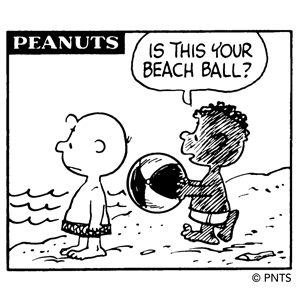Remembering Harriet Glickman
Heroes are hard to come by. I admire a lot of people, but not to the extent to call them a hero. But Harriet Glickman (November 1, 1926–March 27, 2020) truly is MY hero. She passed away this week and this loss has left me reflecting on her tremendous impact, not only on Peanuts but on the lives of all the fans who connected with Franklin, the Peanuts character she helped inspire.
Shortly after the assassination of Rev. Dr. Martin Luther King, Jr., Harriet, then a Los Angeles schoolteacher, wrote to Sparky about integrating the world of Peanuts. She believed that his comic strip could help shape American attitudes on race. The result of their correspondence was the character of Franklin, introduced to Peanuts fans in the summer of 1968.
Of course, I knew of Harriet’s letters to Sparky, but I didn’t know Harriet. The Schulz Museum’s director, Karen Johnson, and I grew to love her as the Museum pursued the story of Franklin for our 2018 exhibition, 50 Years of Franklin. On the day we learned of Harriet’s passing, Karen sent me the following words to share with you.
. . .
One Woman, One Letter, and a Shining Moment
March 28, 2020
This afternoon we received the news that Harriet Glickman has passed away. For those of you who have followed the history and evolution of Peanuts over the years, you understand what an important person Harriet was to all of us at the Museum, and the world for that matter.
In the late 1960s, Harriet was a busy schoolteacher, wife, and mother—and she was concerned about the state of our society, wanting to help in any way she could. As a fan of Peanuts, Harriet knew that somehow the comic strip would be a great way to begin healing the nation for all our citizens. She wrote a very eloquent and polite letter to Mr. Schulz asking him to “integrate” the strip. Mr. Schulz politely wrote back and said that he had thought about it but was afraid that whatever he did would be placating and not sincere and authentic.

Letter from Harriet Glickman to Charles M. Schulz, April 15, 1968. Collection of the Charles M. Schulz Museum and Research Center, Santa Rosa, California.

Letter from Charles Schulz to Harriet Glickman, April 26, 1968. Collection of the Charles M. Schulz Museum and Research Center, Santa Rosa, California.
Harriet wrote back to him, not with disappointment, but with a true sense of understanding what his concerns were. She asked if she may have a few of her “Negro” friends write to him—a few people did, and it must have started him thinking, as soon after, he wrote back to Harriet and let her know that he was introducing a new black character named Franklin.

Letter from Harriet Glickman to Charles M. Schulz, April 27, 1968. Collection of the Charles M. Schulz Museum and Research Center, Santa Rosa, California.
On the 50th anniversary of the debut of Franklin in Peanuts, the Museum curated an exhibition about Franklin’s story with all the original correspondence between Harriet and Charles Schulz on display. At the opening, we created an evening program that featured Robb Armstrong, creator of the comic strip Jump Start and a cartoonist who had been mentored by Charles Schulz, and Harriet Glickman. Robb’s presentation was funny and intelligent, and everyone was entertained. And then Harriet came on stage and talked about her philosophy: that we are all in this together and we must act in any way that is authentic to oneself. She spoke in a strong, calm voice, and with empathy and understanding that not all people can speak out, but if you can, you must. There was complete silence in the auditorium when she spoke—her voice was heard, as she came from a place of empathy for all, while also being very clear that we must act for the Greater Good in the way that fits each of us.

Harriet Glickman and cartoonist Robb Armstrong at the Schulz Museum on August 1, 2018, to celebrate 50 Years of Franklin.
For the next two weeks, both Jean Schulz and I received letters telling us that evening was one of the most meaningful experiences that they had ever been part of. Rob gave us the humor, but Harriet got us all in touch with our humanity and individual responsibility to the Greater Good; she did this without rancor but with an understanding of how hard it can be to act. She insisted that we must ALL do what we can. One letter I received described the night as a “shining moment.”
Jeannie and I have been in contact with Harriet’s family over the past few months and knew that Harriet was fading. She passed away peacefully in her home surrounded by her loving family, with her Peanuts blanket on her bed. May we all carry Harriet Glickman’s spirit of individual action for the Greater Good in all our hearts . . . and as she would say: Do what you can, when you can . . .
She will forever be a wonderful part of Peanuts’ history.
—Karen Johnson, Director, Charles M. Schulz Museum and Research Center
. . .
Harriet Glickman recorded an oral history for the Museum’s archives on May 3, 2014. Here is an excerpt, below:
Like so much of Peanuts, I had taken Franklin for granted, but when we began the research for the 50th anniversary of his debut in the comic strip, I realized how much Sparky had to consider when he introduced a new character. The Peanuts neighborhood is sort of a ‘closed loop,’ so it took a lot of thinking. I consider Franklin’s introduction into the strip a stroke of genius.

Original Peanuts comic strip published on July 31, 1968, introducing the character Franklin. ©Peanuts Worldwide, LLC
—Jean Schulz




